Shoulder Seasons
What is it about shoulder seasons? Are spring and fall truly more poetic or do they just seem that way?
“Margaret are you grieving/Over Goldengrove unleaving?” wrote Gerard Manley Hopkins in his poem “Spring and Fall to a Young Child.”
Autumn and spring are times of great beauty, times when it’s easier to notice the underpinnings of things: the uncoiling of a fern, the thinning of leaves.
I wonder, too, if spring and fall aren’t times of greater yearning, when we see outside our small worlds to what lies beyond.
Author Susan Cain would call these seasons bittersweet, “a tendency to states of longing, poignancy, and sorrow; an acute awareness of passing time; and a curiously piercing joy at the beauty of the world.”









